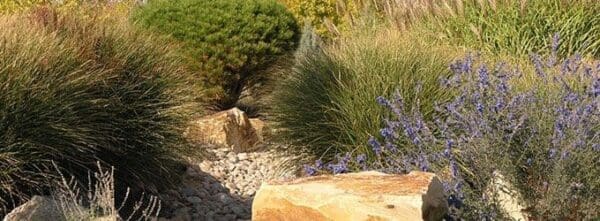Be it a garden, office communal space, restaurant garden, or public park, outdoor spaces are a place where everyone loves to spend time (weather permitting). As such, they have become an extension of our indoor fashions, trends and personalities. Gone are the days of a garden simply being an area without a roof, they’re now so much more.
Landscaping trends are like fashion, whether you like it or not, things change. Colours pallets come and go, styles evolve and the most fashionable materials shift constantly.
Here’s a look at what are set to be 2017’s biggest landscaping trends.
Outdoor Furniture

Human kind spent centuries perfecting indoors – making it comfortable, warm and functional away from the miserable cold outdoors – and now we’re trying to do the same to the outdoors.
Advances in modern materials allow the creation of furniture that is waterproof, fade resistance and comfortable. This has resulted in landscapers creating comfortable living spaces outdoors and away from distractions such as internet, televisions and mobile phones.
Natural Materials

For years, hard-edge landscaping has been the bread and butter of modern outside design. Minimalist, smooth concrete, geometric topography and understated colour schemes are what used to be considered a very 21st century design.
2017 has landscapes moving towards more natural settings. We’re now seeing boulder features (not bolder), rustic railway sleepers and swing seating. Customers are looking more for the ‘DIY’ look (whether they actually do it themselves or not) and steering away from the industrial, clinical, clean designs of the past.
Endemic Plants

As environmental concerns become more and more prevalent to customers, they are asking more and more for a landscape that reflects the needs of the environment. In a recent blog of ours, we discuss how natural landscapes for our native animals and insects are declining and, in turn, so are their population.
‘Locally sourced’ is a buzzword that’s creeping into the landscaping industry with customers looking to stock their gardens with life endemic to the local area. Throw away the cactus and orchids, customers are all about blending in with their local environment and creating a safe haven for bees, butterflies and ladybirds this year. They’re very much looking for a garden to be their own little part of a greater ecosystem.
Vertical Gardening

As landscapers and developers continue to battle in the war of Development Vs Biodiversity, consumers have decided that they are okay with a bit of both.
Vertical gardening has been growing in popularity alongside the rise in housing costs, as fewer and fewer people are able to afford large gardens. Customers are looking for their own green space and so are looking upward not outward.
Brush up on your climbing plants, mosses and vertical planting techniques to stay up to date with this trend. Longevity is key here, you don’t want plants falling off the walls after a season or two.
Xeriscaping

Xeriscaping comes from the Greek ‘Xeros’, meaning dry. Xeriscaping is landscaping for dry, arid and drought conditions. There are a number of reasons why we’ve included this in a UK 2017 Landscaping Trends blog. It’s more relevant than you think.
Xeriscaping is a big trend moving into America, especially in parts where drought is a certainty every summer. The practice focuses around conserving water with slow growing, drought loving plants. They save water, a concern for anyone who’s a little environmental conscious. They’re low maintenance, the slow growing nature means they don’t need that much care, resulting in a good garden for a busy family and, as an added bonus, energy/environmental savings from a lower power tool use.
Secondly, part of the art of xeriscaping is water management, ensuring that there’s always enough water available, regardless of the weather. A big part of this is top-soil management and ensuring that it has the water retaining properties that your garden needs. Read our quick blog on topsoil to find out more.
As this trend begins to grow across the pond, the UK naturally tends to want to follow its occidental partners towards fashion trends – expect to see this as a growing trend in the UK very soon.
